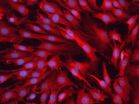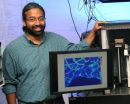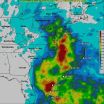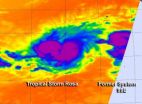"Lung cancer continues to be one of the biggest killers in the United States, and very few treatments directly target it," said Joseph Tuscano, co-principal investigator of the study and professor of hematology and oncology in the UC Davis Department of Internal Medicine. "Our findings may ultimately lead to the identification of a novel and specific therapy for lung cancer."
Lung cancer is the most common cause of death from cancer in both men and women in the United States. Despite new treatments, survival from non-small cell types of lung cancer -- the most common form of the disease -- averages less than one year.
The UC Davis investigation focused on CD22, a cell adhesion molecule, which is a protein located on the surface of a cell. Its function is to bind with other cells or with the extracellular matrix, the non-cellular environment surrounding cells.
The research group has worked on CD22 for many years since finding that B lymphocytes carry CD22, making it a potential target for the treatment of non-Hodgkin's lymphoma, a disease that usually involves an abnormal proliferation of B cells. They developed a monoclonal antibody -- known as HB22.7 -- to target CD22, and it was found to successfully treat non-Hodgkin's lymphoma in mouse models. HB22.7, as well as other monoclonal antibody-based therapies, have little toxicity because they very specifically home in on and destroy cells containing the target antigen, in this case CD22. HB22.7 is currently being prepared for use in human patients in anticipation of clinical trials.
Although the researchers at first thought that CD22 was uniquely expressed on B cells, they discovered serendipitously that it also appears on lung cancer cells, although not on healthy cells in the lung. The investigators found CD22 in seven of the eight cell lines evaluated, which included the major lung cancer subtypes of adenocarcinoma, squamous cell, bronchoalveolar and carcinoid, but not the epidermoid subtype. The authors also examined publicly available databases and discovered that other lung cancer cell lines also expressed CD22.
"Our observation that CD22 is expressed on lung cancer cells is a very exciting discovery, especially since we already have developed a monoclonal antibody that targets this protein," said Robert O'Donnell, professor of hematology and oncology in the UC Davis Department of Internal Medicine and co-principal investigator of the study. "This could bring about a new treatment for a disease that badly needs a new therapeutic approach."
Investigators next tested the effect of treating experimental mouse models of lung cancer with HB22.7. They first implanted tumor cells in the lung, and after the tumors reached a specific size, the mice were given four weekly treatments of either HB22.7 or a placebo. Tumors in the mice treated with HB22.7 grew to only about half the size of those in the control mice.
HB22.7 also had positive results in a model that approximated lung-cancer metastasis, involving the ability of circulating cancer cells to implant themselves into an organ (in this case, the lung) and grow a tumor. For these experiments, lung cancer cells were injected into the bloodstream of mice, followed by four weekly treatments of either HB22.7 or a placebo. At the end of treatment, most of the lung tissue from the control group contained a great deal of tumor -- in one mouse the entire lung was nearly replaced with cancer. The treated mice had virtually no tumor growth in evidence, and only one had microscopic evidence of a single lung tumor.
Furthermore, mice treated with HB22.7 had significantly longer survival: more than 90 percent were still alive at the end of the 84-day trial, while most of the untreated mice had died by the 14th day, and all of them had died by day 40.
"The results of the metastasis experiments were really dramatic," said Tuscano. "They indicate that CD22 may play a significant role in the development of lung-cancer metastasis."
Interestingly, when HB22.7 was tested in a mouse model inoculated with a cell line found to be resistant to HB22.7 when tested in cell culture, tumor growth was also significantly reduced compared to tumors in control mice. According to the authors, the reason for this is unclear, but they suspect that CD22 may have other immunological properties in a living animal, which are not evident in tissue culture.
The research group is currently "humanizing" the monoclonal antibody HB22.7 in anticipation of clinical trials. This involves modifying the protein sequences to make the antibody -- which was derived from mice -- to be more similar to natural antibodies produced by humans.
Because they know that HB22.7 homes in on cancer cells, they also are exploring the use of HB22.7 as a vehicle to deliver drugs to lung cancer, which may make current drug therapy more effective. The article is titled "The CD22 antigen is broadly expressed on lung cancer cells and is a target for antibody-based therapy."
INFORMATION:
Other study authors from UC Davis are Jason Kato, Chengyi Xiong, Yunpeng Ma and David Gandara. Additional authors are David Pearson from the California Northstate University College of Pharmacy in Rancho Cordova, and Laura Newell of Oregon Health and Science University in Portland.
The study was funded almost entirely by private donations and by the deLeuze Family Endowment for a Non-Toxic Cure for Lymphoma.
UC Davis Comprehensive Cancer Center is the only National Cancer Institute-designated center serving the Central Valley and inland Northern California, a region of more than 6 million people. Its specialists provide compassionate, comprehensive care for more than 9,000 adults and children every year, and access to more than 150 clinical trials at any given time. Its innovative research program engages more than 280 scientists at UC Davis, Lawrence Livermore National Laboratory and Jackson Laboratory (JAX West), whose scientific partnerships advance discovery of new tools to diagnose and treat cancer. Through the Cancer Care Network, UC Davis collaborates with a number of hospitals and clinical centers throughout the Central Valley and Northern California regions to offer the latest cancer care. Its community-based outreach and education programs address disparities in cancer outcomes across diverse populations. For more information, visit cancer.ucdavis.edu.
END




